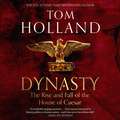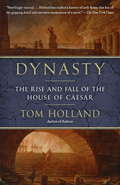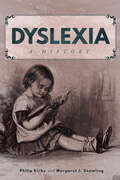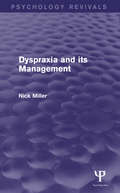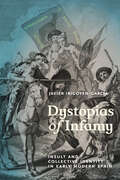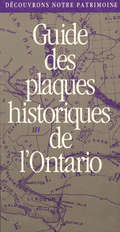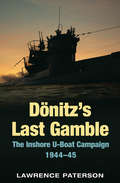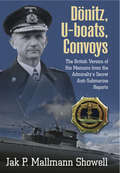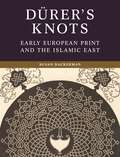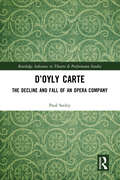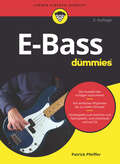- Table View
- List View
Dynasty: The Rise and Fall of the House of Caesar
by Tom HollandDynasty tells the story of Rome's first dynasty of emperors, from its establishment by Augustus Caesar in the last decades of the 1st century BC to its final, florid extinction less than a century later. The line of autocrats known to historians as the 'Julio-Claudians' remains to this day a byword for depravity. The brilliance of its allure and the blood-steeped shadows cast by its crimes still haunt the public imagination. When people think of imperial Rome, it is the city of Tiberius and Caligula, of Claudius and Nero that is most likely to come into their minds. In Dynasty, Tom Holland provides not only a compelling history of this fascinating family, but a portrait of the entire Roman world.
Dynasty: The Rise and Fall of the House of Caesar
by Tom Holland'A masterly account of this first wicked century of the Roman Empire' Sunday Times'Holland does not just tell the story of the reign of the Julio-Claudian family. He knits the history of ancient Rome into his narrative - its founding myths, the fall of the republic, the religious superstitions - with a skill so dextrous you don't notice the stitching. Dynasty is both a formidable effort to compile what we can know about the ancient world and a sensational story' Observer'A witty and skilful storyteller... He recounts with pleasure his racy tales of psychopathic cruelty, incest, paedophilia, matricide, fratricide, assassination and depravity' William Dalrymple, New Statesman'A wonderful, surging narrative... [for] anyone interested in history, politics or human nature - and it has never been better told' Mail on SundayTHE TOP TEN SUNDAY TIMES BESTSELLER
Dynasty: The Rise and Fall of the House of Caesar
by Tom HollandAuthor and historian Tom Holland returns to his roots in Roman history and the audience he cultivated with Rubicon—his masterful, witty, brilliantly researched popular history of the fall of the Roman republic—with Dynasty, a luridly fascinating history of the reign of the first five Roman emperors. Dynasty continues Rubicon's story, opening where that book ended: with the murder of Julius Caesar. This is the period of the first and perhaps greatest Roman Emperors and it's a colorful story of rule and ruination, running from the rise of Augustus through to the death of Nero. Holland's expansive history also has distinct shades of I Claudius, with five wonderfully vivid (and in three cases, thoroughly depraved) Emperors—Augustus, Tiberius, Caligula, Claudius, and Nero—featured, along with numerous fascinating secondary characters. Intrigue, murder, naked ambition and treachery, greed, gluttony, lust, incest, pageantry, decadence—the tale of these five Caesars continues to cast a mesmerizing spell across the millennia.
Dyslexia: A History
by Margaret J. Snowling Philip KirbyIn 1896 the British physician William Pringle Morgan published an account of “Percy,” a “bright and intelligent boy, quick at games, and in no way inferior to others of his age.” Yet, in spite of his intelligence, Percy had great difficulty learning to read. Percy was one of the first children to be described as having word-blindness, better known today as dyslexia. In this first comprehensive history of dyslexia Philip Kirby and Margaret Snowling chart a journey that begins with Victorian medicine and continues to dyslexia’s current status as the most globally recognized specific learning difficulty. In an engaging narrative style, Kirby and Snowling tell the story of dyslexia, examining its origins and revealing the many scientists, teachers, and campaigners who put it on the map. Through this history they explain current debates over the diagnosis of dyslexia and its impact on learning.For those who have lived experience of dyslexia, professionals who have supported them, and scholars of social history, education, psychology, and childhood studies, Dyslexia reflects on the place of literacy in society – whom it has benefited, and whom it has left behind.
Dyspraxia and its Management (Psychology Revivals)
by Nick MillerDyspraxia is a disorder of voluntary, purposeful, learned movement and is one of the most common sequelae of stroke, head-injury, neoplasm and abnormal ageing. It is also a major complicating factor in the assessment and treatment of acquired language, visual-spatial and other movement disorders. Dyspraxics are found not only in specialist neurological units, but also in rehabilitation centres, general medical and surgical wards, geriatric units and in the community. Despite this there was little systematic discussion of dyspraxia in major texts on stroke, head injury, rehabilitation or movement disorders at the time. Originally published in 1986, one aim of this book was to correct the imbalance in the attention paid to the disorder. The emphasis of the book is practical, dealing with the recognition and assessment of dyspraxic dysfunction, and guidelines and issues in its remediation. Theoretical issues are covered in relation to their bearing on clinical management. It was the standard textbook on the topic for many years and directly relevant at the time to clinicians in the fields of clinical psychology, occupational therapy and physiotherapy, speech therapy, neurology and geriatrics.
Dystopia's Provocateurs: Peasants, State, and Informality in the Polish-German Borderlands
by Edyta MaterkaToward the end of the Second World War, Poland’s annexation of eastern German lands precipitated one of the largest demographic upheavals in European history. Edyta Materka travels to her native village in these "Recovered Territories," where she listens carefully to rich oral histories told by original postwar Slavic settlers and remaining ethnic Germans who witnessed the metamorphosis of eastern Germany into western Poland. She discovers that peasants, workers, and elites adapted war-honed informal strategies they called "kombinacja" to preserve a modicum of local agency while surviving the vicissitudes of policy formulated elsewhere, from Stalinist collectivization to the shock doctrine of neoliberalism. Informality has taken many forms: as a way of life, a world view, an alternate historical text, a border memory, and a means of magical transformation during times of crisis. Materka ventures beyond conventional ethnography to trace the diverse historical, literary, and psychological dimensions of kombinacja. Grappling with the legacies of informality in her own transnational family, Materka searches for the "kombinator within" on the borderlands and shares her own memories of how the Polish diaspora found new uses for kombinacja in America.
Dystopias of Infamy: Insult and Collective Identity in Early Modern Spain (Campos Ibéricos: Bucknell Studies in Iberian Literatures and Cultures)
by Javier Irigoyen-GarcíaInsults, scorn, and verbal abuse—frequently deployed to affirm the social identity of the insulter—are destined to fail when that language is appropriated and embraced by the maligned group. In such circumstances, slander may instead empower and reinforce the collective identity of those perceived to be a threat to an idealized society. In this innovative study, Irigoyen-Garcia examines how the discourse and practices of insult and infamy shaped the cultural imagination, anxieties, and fantasies of early modern Spain. Drawing on sixteenth- and seventeenth-century literary works, archival research, religious and political literature, and iconographic documents, Dystopias of Infamy traces how the production of insults haunts the imaginary of power, provoking latent anxieties about individual and collective resistance to subjectification. Of particular note is Cervantes’s tendency to parody regulatory fantasies about infamy throughout his work, lampooning repressive law for its paradoxical potential to instigate the very defiance it fears.
Découvrons Notre Patrimoine: Guide des plaques historiques de l'Ontario
by Mary Ellen Perkins Nicole AndreDepuis que le programme de commémoration historique a été inauguré par le gouvernement de l’Ontario en 1956, plus de 1 000 plaques ont été érigées d’un bout à l’autre de la province. La variété des sujets commémorés est étonnante, qu’il s’agisse de ruées vers les mines du nord de l’Ontario ou de l’invention de la vis à tête creuse … de Harold Innis ou de Stephen Leacock … de l’épidemie de typhus de 1847 ou de la découverte de l’insuline. La culture populaire est également bien représentée: "Beautiful Joe" commémore un roman célêbre dans le monde entier racontant l’histoire d’un chien ; "When You and I Were Young, Maggie" chante une ballade romantique très en vogue ; "Jumbo" marque l’emplacement où est mort un éléphant de cirque très aimé. L’histoire de l’Ontario, tout comme sa géographie et ses habitants, est vaste et variée. Ce guide peut donc être utile, que l’on circule sur l’autoroute, se promène a la campagne ou flâne dans son propre quartier. Il reste encore tant à découvrir.
Déjà Viewed: Nation, Gender, and Genre in Bollywood Remakes of Hollywood Cinema (SUNY series, Horizons of Cinema)
by Gohar SiddiquiSituates the remake as one of the primary responses to Bollywood's globalization and corporatization.Focused on post-1990 Bollywood remakes of Hollywood films, Déjà Viewed tells a larger story of the rapidly changing Indian film industry in the wake of globalization and corporatization. It situates the remake as a gendered response to these changes, drawing on approaches from film theory, gender studies, and cultural studies. The book looks at films from a variety of genres and modes, including the Bollywood family film, romantic comedy, noir, and melodrama, and each film's close analysis is accompanied by attention to concerns related to remake theory, such as homage, anxiety of influence, defamiliarization, and pastiche. Seeking to historicize how gender and genres become translated and transformed in the Bollywood remake, the book contributes to transnational understandings of gender and genre as media texts move across various borders—geographic, cinematic, economic, and aesthetic.
Désirée
by Annemarie Selinko"An epic love story...irresistible reading." -Chicago Tribune To be young, in France, and in love: fourteen year old Desiree can't believe her good fortune. Her fiance, a dashing and ambitious Napoleon Bonaparte, is poised for battlefield success, and no longer will she be just a French merchant's daughter. She could not have known the twisting path her role in history would take, nearly breaking her vibrant heart but sweeping her to a life rich in passion and desire. A love story, but so much more, Désirée explores the landscape of a young heart torn in two, giving readers a compelling true story of an ordinary girl whose unlikely brush with history leads to a throne no one would have expected. An epic bestseller that has earned both critical acclaim and mass adoration, Désirée is at once a novel of the rise and fall of empires, the blush and fade of love, and the heart and soul of a woman. "This is a fascinating panorama, from the blood-and-sawdust reek of Robespierre's guillotine to the final collapse of the Hundred Days." -New York Times What Readers Are Saying "An absolutely marvelous story about a courageous woman in a difficult time who made difficult choices... one of the best books I have ever read." "Désirée seems to come alive when I read, and I become her. This book is so romantic, so colorful and full of adventure." "This book has meant so much to so many women." "History has never before been as human as it is here, told through the pages of Désirée's (fictitious) diary."
Désirée Congo (CARAF Books)
by Évelyne TrouillotThe newest English translation of one of Haiti&’s most powerful literary voices Désirée Congo is a riveting, powerful, and profoundly original novel set in the final years of the Haitian Revolution at the dawn of the nineteenth century. In this richly textured work, Trouillot—one of the leading voices of the francophone literary world—constructs an intricate narrative web from the varied experiences of freedmen and women, maroons, enslaved African people and their Creole children, as well as French planters and white smallholders in colonial Saint-Domingue at a historical moment of unthinkable upheaval. It is a moving, lyrical book whose strikingly realized characters enrich our understanding of the last confrontations between the Haitian revolutionaries and Napoleon&’s imperial forces—a conflict that resulted in the success of the largest slave revolt in recorded history and the independence of the first Black state in the western hemisphere.
Désirée: The Bestselling Story of Napoleon's First Love
by Annemarie SelinkoThe stunning, massively bestselling story of Napoleon's first fiancé. First published in 1953, this riveting true-life tale comes to life in diary form, giving readers an inside glimpse at the young Napoleon and his family. Désirée is enchanted by the young officer, and he asks her to marry him. But he must leave for Paris, where he meets his eventual wife Josephine. A heartbroken Désirée is unsure she'll ever find anyone again. A love story, but so much more, Désirée is the tale of a simple merchant's daughter who ends up with a kind of royalty she never expected: an unforgettable story just waiting to be reborn.
Días de gloria: Vida y muerte del Fraile Aldao
by Omar López Mato¿Por qué los libros no recuerdan a este caudillo? ¿Podrá Dios perdonarlesus pecados? Nunca lo sabremos, pero sí estamos seguros de que se locondenó al olvido. La figura del Fraile resulta incómoda a todos losespectadores por igual. Aldao fue encerrado en un limbo, desdeñado tantopor seguidores como enemigos de su causa. Sin embargo, no fue peor quemuchos de los actores de su época que han merecido homenajes y honores. El Fraile José Félix Aldao pidió que lo enterraran con su sotana, perotambién con su sable y las condecoraciones que ganó a lo largo de sucarrera militar. Apóstata, mujeriego, proclive a los excesos en labebida y la violencia, fue uno de los oficiales de San Martín, héroe deChacabuco y Maipú, conocido por su valor temerario conduciendo a losinsurgentes del Perú. Adepto a la política de Juan Manuel de Rosas,participó junto al Restaurador en la Campaña del Desierto. Fuegobernador por dos períodos en Mendoza y el custodio más eficaz de lafrontera de dicha provincia.La novela de Omar López Mato reconstruye minuciosamente la vida delFraile, su agonía y el lento proceso de reconciliación con la Iglesiaque lo obliga a abandonar a las mujeres con las que convivía, paraganarse las puertas del cielo. El libro sirve para narrar también elprimer medio siglo de historia argentina, desde la guerra de laIndependencia contra los españoles hasta las luchas internas entreunitarios y federales.Esta es la vida de un guerrero de la patria que dejó el breviario paraprenderse el sable a la sotana. El Fraile Aldao, un olvidado de nuestrahistoria, que también, supo darle días de gloria.
Días de ira, noches de pasión (Un romance en Londres #Volumen 3)
by Nieves HidalgoÉl quiere desenmascarar a la que creía una timadora.Ella se resiste a contarle su secreto. ¿Qué camino tomar cuando la pasión se interpone? ¿Se puede traicionar al corazón? Sabrina Klever nunca pensó que, cuando todo le había dado la espalda, el conde de Lancashire la salvaría. Tampoco imaginó que casi seis años después se encontraría, cara a cara, con el último hombre al que hubiera deseado volver a ver: el barón de Sheringham, que acaba de regresar de la guerra contra Napoléon. El barón de Sheringam ha regresado con el único deseo de olvidar los horrores de la guerra. Lo único que le ha mantenido cuerdo ha sido evocar unos ojos violetas que lo atan a un pasado feliz, antes de conocer la furia de un tiempo de sangre y muerte. Sin embargo, cuando encuentra a Sabrina viviendo en casa de su abuelo y a pesar de la profunda atracción que siente por ella, no está dispuesto a que manejen sus sentimientos. Su misión es otra: desenmascarar a la mujer que pretende quedarse con parte de su patrimonio. Aunque para ello tenga que renunciar a la pasión.
Días de muertos
by Alma GuillermoprietoDos artículos de Alma Guillermoprieto, galardonada este año con el Premio Princesa de Asturias de Comunicación y Humanidades. Días de muertos y Un centenar de mujeres son dos textos recogidos en la antología Desde el país de nunca jamás, una colección de artículos de Alma Guillermoprieto publicados entre 1980 y 2008 en The Washington Post, The New Yorker y The New York Review of Books. A través de un minucioso y descarnado retrato, la periodista mexicana explora la compleja realidad de América Latina de los últimos años. Días de muertos es una reflexión sobre el impacto y corrosión que ha provocado el narcotráfico en la sociedad mexicana. La periodista se centra en la ciudad de Sinaloa como paradigma de la crisis en México; un reflejo de violencia, criminalidad y corrupción desatadas a raíz de la guerra de las drogas. El segundo texto, Un centenar de mujeres, es una crónica escalofriante escrita en 2003 sobre los feminicidios de Ciudad Juárez y Chihuahua. Guillermoprieto pone el foco en la historia de José Rayas, un importante líder sindicalista cuya hija de dieciséis años fue asesinada. El caso no fue suficientemente investigado y permanece rodeado de incógnitas. Rayas, al igual que la mayoría de familias afectadas por esta ola de feminicidios, nunca sabrá si se hizo justicia, si se investigó el asesinato en profundidad ni si se arrestó al verdadero asesino. A día de hoy, los crímenes de Ciudad Juárez aún continúan envueltos en la más absoluta impunidad. Sobre Desde el país de nunca jamás:«Magistral. América Latina ya tiene su Orwell.»David Remnick «Alma Guillermoprieto se enfrenta a la vida con un cuaderno y un bolígrafo en la mano. Es su forma de vida. Es su pasión. Y la disfruta con toda la intensidad posible.»Milenio «Su periodismo temerario, al igual que sus espléndidas descripciones y sus retratos de personajes, son fascinantes.»The Wall Street Journal «Una maravillosa lectura, repleta de humanidad, astucia, curiosidad y conocimiento.»The New York Times Book Review
Días de tempestad
by Brenna WatsonPor la autora de La rosa de Hereford Cuando te arrebatan a tu familia y tu pasado, tu única opción es la venganza. Londres, 1839. La alta sociedad londinense se pregunta quién es esa extraña americana que se ha instalado en una de las mejores mansiones de Mayfairy que ha irrumpido en los eventos más exclusivos de la temporada del brazo de un viejo conde retirado de la vida pública. Pronto, las vidas de muchos comenzarán a verse afectadas por la presencia de esa enigmática mujer. Entre ellas, la de Alexander Lockhart, tercer hijo del conde de Woodbury, cuya existencia dará un vuelco inesperado desde el mismo instante en que sus miradas se crucen. Lo que nadie sabe es que Temperance Whitaker no ha venido a pavonearse por los salones londinenses ni a la caza de un título nobiliario. Nadie sospecha que, bajo su fachada sofisticada y misteriosa, oculta un secreto, y que solo ha viajado a Inglaterra con un propósito: vengarse de quienes destruyeron la vida de su familia y la suya propia. Fluyen tranquilas las aguas del Támesis… pero la tempestad está a punto de desatarse. Reseñas: «Si no conocéis la pluma de Brenna Watson, os invito encarecidamente a descubrirla. Todo lo que os pueda decir se quedaría corto». @vivirmilvidas «Empezar a leer un libro de Brenna Watson es zambullirse en su mundo. Olvidas lo que tienes a tu alrededor mientras lo devoras». Merimeri, Amazon«Con cada novela suya me enamora más de su forma de contar las cosas». Ana Glez Duque, Amazon «Su pluma es de esas que se viven con ganas, con pasión y que te mantienen enganchada a sus páginas hasta que te has fundido el libro entero». @huntress_of_books
Dönitz and the Wolf Packs: The U-boats At War (Military Classics)
by Bernard EdwardsOn 17 September 1942 Admiral Karl Donitz, C-in-C U-boats, issued the following directive:To all Commanders - 'All attempts to rescue members of ships sunk, therefore also fishing out swimmers and putting them into lifeboats, righting capsized lifeboats, handing out provisions and water, have to cease. Rescue contradicts the most fundamental demands of war for the annihilation of enemy ships and crews'.This order ended what had hitherto been a war in which the opposing factions treated each other with a certain respect, seaman to seaman, showing mercy where mercy was due. It also marked the point at which the Battle of the Atlantic became a dirty war of attrition, with the U-boats hunting in packs snarling and snapping at the heels of the hard-pressed convoys. Ships began to go down like corn before the reaper, men were dying in their hundreds in the cold grey waters of the great ocean. This was a battle without quarter. A battle the U-boats would have won had it not been for the grit and determination of the convoy escorts and the unflagging resilience of the men who manned the vulnerable merchant ships.This book faithfully records the progress of the Battle of the Atlantic, which began within hours of the declaration of war on 3 September 1939 and continued without let-up until the last torpedo was fired on the night of 7 May 1945, just one hour before Germany surrendered. The story is told from both sides of the periscope.
Dönitz's Last Gamble: The Inshore U-Boat Campaign 1944-45
by Lawrence Paterson&“The tragic final year of Hitler&’s once highly effective U-Boat campaign against Allied shipping is graphically and grippingly told here.&” —Work Boat World By the end of 1943 the German submarine war on Atlantic convoys was all but defeated, beaten by superior technology, code-breaking and air power. With losses mounting, Karl Dönitz withdrew the wolfpacks, but in a surprise change of strategy, following the D-Day landings in June 1944, he sent his U-boats into coastal waters, closer to home, where they could harass the crucial Allied supply lines to the new European bridgehead. Caught unawares, the British and American navies struggled to cope with a novel predicament—in shallow waters submarines could lie undetectable on the bottom, and given operational freedom, they rarely needed to make signals, neutralizing the Allied advantages of decryption and radio direction-finding. Behind this unpleasant shock lay an even greater threat, of radically new submarine types known to be nearing service. Dönitz saw these as war-winning weapons, and gambled that his inshore campaign would hold up the Allied advance long enough to allow these faster and quieter boats to be deployed in large numbers. This offensive was perhaps Germany&’s last chance to turn the tide, yet, surprisingly, such an important story has never been told in detail before. That it did not succeed masks its full significance: in the Cold War that followed, the massive Soviet submarine fleet—built on captured German technology and tactical experience—became a very real menace to Western sea power. In this way, Dönitz&’s last gamble set the course of post-war antisubmarine development.
Dönitz, U-boats, Convoys: The British Version of His Memoirs from the Admiralty's Secret Anti-Submarine Reports
by Jak P. Mallmann ShowellThis unique WWII history combines the memoirs of a Nazi Admiral with secret British naval reports for a comprehensive view of the U-Boat war. The memoirs of Admiral Karl Dönitz, Ten Years and Twenty Days, are a fascinating first-hand account of the Battle of the Atlantic as seen from the headquarters of the U-boat fleet. Now, noted naval historian Jak P. Mallmann Showell has combined Dönitz's memoirs in a parallel text with the British Admiralty's secret Monthly Anti-Submarine Reports to produce a unique view of the U-boat war as it was perceived at the time by both sides. The British Monthly Anti-Submarine Reports were classified documents issued only to senior officers hunting U-boats. They were supposed to have been returned to the Admiralty and destroyed at the end of the War, but by chance a set survived in the archives of the Royal Navy's Submarine Museum in Gosport. They offer significant and hitherto unavailable insight into the British view of the Battle of the Atlantic as it was being fought. With expert analysis of these firsthand sources from opposing sides of the conflict, Jak P. Mallmann Showell presents what may be the most complete contemporary account of the desperate struggle in the North Atlantic during the Second World War.
Dürer’s Knots: Early European Print and the Islamic East
by Susan DackermanAn important new examination of Islamic themes in the art of Albrecht DürerAlbrecht Dürer&’s depictions of Muslim figures and subjects are considered by many to be among his most perplexing images. This confusion arises from the assumption that the artist and his northern European contemporaries regarded the Muslim Levant as an exotic faraway land inhabited by hostile adversaries, not a region of neighboring empires affiliated through political and mercantile networks. Susan Dackerman casts Dürer&’s art in an entirely new light, focusing on prints that portray cooperation between the Muslim and Christian worlds rather than conflict and war, enabling us to better understand early modern Europe through its visual culture.In this beautifully illustrated book, Dackerman provides new readings of three of the artist&’s most enigmatic print projects—Sea Monster, Knots, and Landscape with Cannon—situating them within historical contexts that reflect productive collaborations between Christendom and Islam, from the artistic and commercial to the ideological and political. Dackerman notes how Gutenberg&’s development of printing shares an inextricable relationship to the 1453 Ottoman siege of Constantinople. While Gutenberg&’s workshop produced a call to crusade and other publications antagonistic to the Muslim East, Dürer&’s prints, she shows, instead emphasize instances of affiliation between Christendom and Islam.A breathtaking work of scholarship, Dürer&’s Knots shows how the artist&’s prints of Muslim subjects give expression to the interconnectedness of Christian Europe and the Islamic East.
D’Oyly Carte: The Decline and Fall of an Opera Company (Routledge Advances in Theatre & Performance Studies)
by Paul SeeleyThis book considers and discusses aspects of the management of the D’Oyly Carte Opera Company in the twentieth century since the death of its founder Richard D’Oyly Carte, and concentrates on key events that contributed to its demise in 1982. In this book, Paul Seeley follows the analytical model that proposes no single factor triggered the collapse, but rather several, both external and internal. In the case of an opera company the external factors may include public taste and market forces, but more significant are the internal factors such as the management decisions taken in response to external factors and how these compare with the original artistic aims, aspirations and business models of the founder. This is a study by someone with close observation of the administration; at the 1982 demise, Seeley was assistant to the company manager, having earlier served on the music staff. The book is a must-read for music historians, theatre historians and arts-management professionals; as an uncompromisingly critical history of the D'Oyly Carte Opera Company it is designed to serve a wider public, not just the Gilbert and Sullivan opera specialist, but anyone keen to debate the desirability of private or public sponsorship of the performing arts.
E(n)stranged: Rethinking Defamiliarization in Literature and Visual Culture
by Nilgun Bayraktar Alberto GodioliVariously translated as “estrangement,” “enstrangement” or “defamiliarization,” Viktor Shklovsky’s concept of ostranenie is more relevant than ever. This collection offers new insights into the theories and practices of ostranenie across various languages and cultures, with a particular focus on the 20th and 21st centuries. Our current era is marked by a dramatic redefinition of the normal and the strange, the familiar and the weird. The rise of far-right populism has increasingly normalized xenophobic and nativist stances previously confined to the fringes of the political spectrum. Additionally, the climate crisis has led to the ongoing renegotiation of the concepts of normalcy and emergency amid widespread efforts to adapt to the “new (ab)normal.” Exploring defamiliarization provides a unique perspective to comprehend and question these processes and their profound cultural implications. Focusing on ostranenie also offers valuable insights into how aesthetic forms serve a political function. Defamiliarization can take on various forms, including retro-futuristic dystopias, stylized films, and darkly humorous cartoons and memes. It can be an effective tool for political activation that relies on formal innovation rather than superficial emotional engagement. This collection brings together the work of a group of scholars examining defamiliarization across different media. It explores questions such as: How can we differentiate between various forms of defamiliarization and analyze their effects on the reader/viewer? How is defamiliarization connected to the weird, the eerie, or the uncanny? As a result, the collection offers an updated theoretical framework for understanding the wide range of emergent artistic and literary practices of e(n)strangement in the current era and their significant political affordances. Chapter 6 is available open access under a Creative Commons Attribution 4.0 International License via link.springer.com
E-Bass für Dummies (Für Dummies)
by Patrick PfeifferAuch wenn ihm die Lead-Gitarre oft die Show stiehlt - wer sich ein wenig mit Musik auskennt, weiß, dass ohne den Bass alles nur halb so gut klingt. Schon lange sind Bassisten nicht mehr nur die Männer im Hintergrund. "E-Bass für Dummies" zeigt Ihnen anschaulich und unterhaltsam die Besonderheiten des Instruments. Patrick Pfeiffer erklärt Ihnen Schritt für Schritt, wie der E-Bass gespielt wird und was es zu Noten, Saitenspannung, Harmonien und vielem mehr zu wissen gibt. Da sind flinke oder coole Bassläufe kein Problem mehr und einer Bassistenkarriere steht nichts mehr im Wege!
E-Cigarettes and the Comparative Politics of Harm Reduction: History, Evidence, and Policy
by Ronald Bayer Wayne Hall Virginia Berridge Amy L. FairchildThis open access book offers the first in-depth study of the history and current debates surrounding electronic cigarettes comparing the UK, US and Australia. Since their introduction, e-cigarettes have been the subject of much public, media and regulatory attention, with discussion centring on whether these devices encourage or discourage smoking. This study delves into the history of policymaking and institutions in three countries which have taken different approaches to the regulation of e-cigarettes. In the UK, the tradition of harm reduction through nicotine has helped form a response which has endorsed e-cigarettes, though not without considerable controversy. In contrast, the US has a cessation-only anti-tobacco agenda, and Australia has effectively banned e-cigarettes. This book argues that each country frames the long-term use of nicotine differently and prioritises the health of different groups within the population of smokers or non-smokers, set against a broad backdrop of national responses to addiction. By taking this comparative approach, the authors explore the relationship between history, evidence and policy in public health more widely.
E-Service: New Directions in Theory and Practice
by Roland T. Rust P.K. KannanThe advent of the era of "e-Service," the provision of services over electronic networks like the internet, is one of the dominant business themes of the new millennium. It reflects the fundamental shift in the economy from goods to services and the explosive expansion of information technology. This book provides a collection of different perspectives on e-Service and a unified framework to understand it, even as the business community grapples with the concept. It features contributions from key researchers and practitioners from both the private and public sectors, as well leading scholars from the fields of marketing, information systems, and computer science. They focus on three key areas: the customer-technology interface; e-Service business opportunities and strategies; and public sector e-Service opportunities. The insights they offer will be equally useful to students, scholars, and practitioners.

